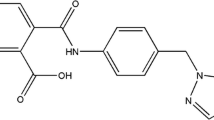Abstract
Three isomers of hydroxy substituted N-aryl-1, 8-naphthalimides based on N-aryl naphthalic anhydride fluorophore have been synthesized. The decrease in fluorescence intensity from ortho to para substitution of hydroxy group on N-aryl reveals that para substituted isomer undergoes ESEC (Excited State with Extended Conjugation) mechanism which is proved by low quantum yield and appearance of dual emission. The ortho isomer, however, has high quantum yield and no tautomer emission, indicating ESIPT (Excited State Intramolecular Proton Transfer) mechanism is not operating. Similarly, all these isomers show strong fluorescence quenching in presence of strong H-bonding solvents like DMSO and pyridine, but there was neither the shift of emission bands nor the appearance of new bands for proton transfer to these solvents. Thus, it also indicates the absence of excited state proton transfer mechanism. Both the ortho isomer, and to a greater degree the meta isomer, showed larger quenching constants (Kapp) with pyridine than DMSO. This trend opposes the hydrogen-bond affinity for these solvents with phenol and points to a 2-point recognition interaction. In addition, a naphthalimide derivative using 2-aminoimidazole was prepared and examined for optimal positioning of a six-membered ring hydrogen bond pattern. No dual fluorescence was observed for this compound either.










Similar content being viewed by others
References
Demchenko A (2005) Lab Chip 5:1210–1223 doi:10.1039/b507447a
Grabowski Z, Rotkiewicz K, Rettig W (2003) Chem Rev 103:3899–4031 doi:10.1021/cr940745l
Druzhinin SI, Kovalenko SA, Senyushkina TA, Demeter A, Machinek R, Noltemeyer M, Zachariasse KA (2008) J Phys Chem A 112:8238–8253
Yoshihara T, Druzhinin SI, Demeter A, Kocher N, Stalke D, Zachariasse KA (2005) J Phys Chem A 109:1497–1509
Zachariasse KA, Druzhinin SI, Bosch W, Machinek R (2004) J Am Chem Soc 126:1705–1715
Zachariasse KA, Yoshihara T, Druzhinin SI (2002) J Phys Chem A 106:6325–6333
Iwashita Y, Sugiyasu K, Ikeda M, Fujita N, Shinkai S (2004) Chem Lett 33:1124–1125 doi:10.1246/cl.2004.1124b
Haidekker MA, Theodorakis EA (2007) Org Biomol Chem 5:1669–1678 doi:10.1039/b618415dc
Kobiro K, Inoue Y (2003) J Am Chem Soc 125:421–427 doi:10.1021/ja028401xd
Yang CY, Liu Y, Zheng D, Zhu JC, Dai J (2007) J Photochem Photobiol Chem 188:51–55 doi:10.1016/j.jphotochem.2006.11.017e
Jones G, Jimenez JAC (2001) J Photochem Photobiol B-Biology 65:5–12
Papper V, Kharlanov V, Schadel S, Maretzki D, Rettig W (2003) Photochem Photobiol Sci 2:1272–1286
Yang J-S, Hwang C-Y, Chen M-Y (2007) Tet Lett 48:3097–3102
Klymchenko AS, Demchenko AP (2002) J Am Chem Soc 124:12372–12379 doi:10.1021/ja027669lb
Klymchenko AS, Ozturk T, Pivovarenko VG, Demchenko APN (2003) J Chem 27:1336–1343 doi:10.1039/b302965d
Weller AH (1956) Z Electrochem 60:1144
McMorrow D, Kasha M (1984) J Phys Chem 88:2235–2243 doi:10.1021/j150655a012
Formosinho SJ, Arnaut LG (1993) Photochem Photobiol A-Chemistry 75:21–48
Legourrierec D, Ormson SM, Brown RG (1994) Prog React Kin 19:211–275
Santara S, Krishnamoorthy G, Dogra SK (2000) J Phys Chem A 104:476–482 doi:10.1021/jp992678a
Yushchenko DA, Bilokin MD, Pyvovarenko OV, Duportail G, Mely Y, Pivovarenko VG (2006) Tet Lett 47:905–908 doi:10.1016/j.tetlet.2005.11.160
Inoue Y, Jiang P, Tsukada E et al (2002) J Am Chem Soc 124:6942–6949 doi:10.1021/ja016858l
Demeter A, Bérces T, Hinderberger J, Timåri G (2003) Photochem Photobiol Sci 2:273–281 doi:10.1039/b210592f
Demeter A, Bercés T, Biczok L, Wintgens V, Valat P, Kossanyi J (1996) J Phys Chem 100:2001–2011 doi:10.1021/jp951133n
Cao H, Chang V, Hernandez R, Heagy MD (2005) J Org Chem 70:4929–4934 doi:10.1021/jo050157f
Gillespie AM (1985) A manual of fluorometric and spectrophotometric experiments. Gordon and Breach Science, New York
Gaussian 03, Revision D.01, Frisch MJ, Trucks GW, Pople JA et al (2004) Gaussian, Inc., Wallingford CT
Hoa GHB, Kossanyi J, Demeter A, Biczok L, Bercés T (2004) Photochem Photobiol Sci 3:473–482 doi:10.1039/b313804f
Anslyn EV, Dougherty DA (2006) Modern physical organic chemistry. University Science Books, Sausalito, CA, p 953
Tolbert LM, Haubrich JE (1994) J Am Chem Soc 116:10593–10600 doi:10.1021/ja00102a028b
Weller A (1961) Progress in Reaction Kinetics vol. 1. In: Porter G (ed) Pergamon, p.187–214
Herbich J, Rettig W, Thummel RP, Waluk J (1992) Chem Phys Lett 195:556–562 doi:10.1016/0009-2614(92)85562-O
Biczok L, Valat P, Wintgens V (1999) Phys Chem Chem Phys 1:4759–4766 doi:10.1039/a904520a
Joesten MD, Schaad L (1974) Hydrogen bondin. J Marcel Dekker, Inc, New York
Lakowicz JR (1999) Principles of Fluorescence Spectroscopy, 2nd ed. Kluwer Academic/Plenum, p 243
Coskun A, Akkaya EU (2004) Org Lett 6:241–243 doi:10.1021/ol0488744
Wintgens V, Valat P, Kossanyi J, Demeter A, Biczok L, Bercés TN (1996) New J Chem 20:1149–1158
Acknowledgements
The authors thank the NIH-NIGMS for providing financial support.
Author information
Authors and Affiliations
Corresponding author
Electronic supplementary material
Below is the link to the electronic supplementary material.
ESM 1
Appendix II. Flourescence data. (DOC 612 KB)
Appendix I: photophysical properties
Appendix I: photophysical properties


Rights and permissions
About this article
Cite this article
Paudel, S., Nandhikonda, P. & Heagy, M.D. A Comparative Study into Two Dual Fluorescent Mechanisms via Positional Isomers of N-hydroxyarene-1,8-naphthalimides. J Fluoresc 19, 681–691 (2009). https://doi.org/10.1007/s10895-009-0462-2
Received:
Accepted:
Published:
Issue Date:
DOI: https://doi.org/10.1007/s10895-009-0462-2



